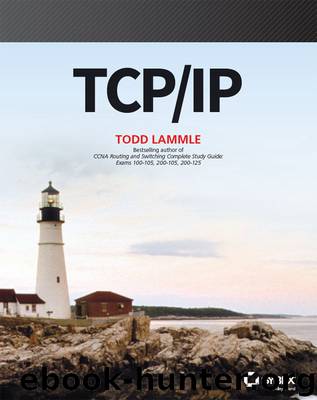TCP IP by Todd Lammle

Author:Todd Lammle [Lammle, Todd]
Language: eng
Format: azw3
ISBN: 9781119472704
Publisher: Wiley
Published: 2017-10-23T04:00:00+00:00
To find up-to-the minute updates for this chapter, please see www.lammle.com/ccna or the book’s web page at www.sybex.com/go/ccna.
Subnetting Basics
In Chapter 1, “Introduction to TCP/IP,” you learned how to define and find the valid host ranges used in a Class A, Class B, and Class C network address by turning the host bits all off and then all on. This is very good, but here’s the catch: you were defining only one network, as shown in Figure 2.1.
Figure 2.1 One network
By now you know that having one large network is not a good thing because the chapter you just read was veritably peppered with me incessantly telling you that! But how would you fix the out-of-control problem that Figure 2.1 illustrates? Wouldn’t it be nice to be able to break up that one, huge network address and create four manageable networks from it? You betcha it would, but to make that happen, you would need to apply the infamous trick of subnetting because it’s the best way to break up a giant network into a bunch of smaller ones. Take a look at Figure 2.2 and see how this might look.
Download
This site does not store any files on its server. We only index and link to content provided by other sites. Please contact the content providers to delete copyright contents if any and email us, we'll remove relevant links or contents immediately.
Sass and Compass in Action by Wynn Netherland Nathan Weizenbaum Chris Eppstein Brandon Mathis(7781)
Grails in Action by Glen Smith Peter Ledbrook(7696)
Configuring Windows Server Hybrid Advanced Services Exam Ref AZ-801 by Chris Gill(6563)
Azure Containers Explained by Wesley Haakman & Richard Hooper(6550)
Running Windows Containers on AWS by Marcio Morales(6081)
Kotlin in Action by Dmitry Jemerov(5065)
Microsoft 365 Identity and Services Exam Guide MS-100 by Aaron Guilmette(4914)
Combating Crime on the Dark Web by Nearchos Nearchou(4498)
Management Strategies for the Cloud Revolution: How Cloud Computing Is Transforming Business and Why You Can't Afford to Be Left Behind by Charles Babcock(4414)
Microsoft Cybersecurity Architect Exam Ref SC-100 by Dwayne Natwick(4334)
The Ruby Workshop by Akshat Paul Peter Philips Dániel Szabó and Cheyne Wallace(4170)
The Age of Surveillance Capitalism by Shoshana Zuboff(3950)
Python for Security and Networking - Third Edition by José Manuel Ortega(3738)
Learn Windows PowerShell in a Month of Lunches by Don Jones(3508)
The Ultimate Docker Container Book by Schenker Gabriel N.;(3407)
Mastering Python for Networking and Security by José Manuel Ortega(3344)
Mastering Azure Security by Mustafa Toroman and Tom Janetscheck(3330)
Blockchain Basics by Daniel Drescher(3294)
Learn Wireshark by Lisa Bock(3259)
